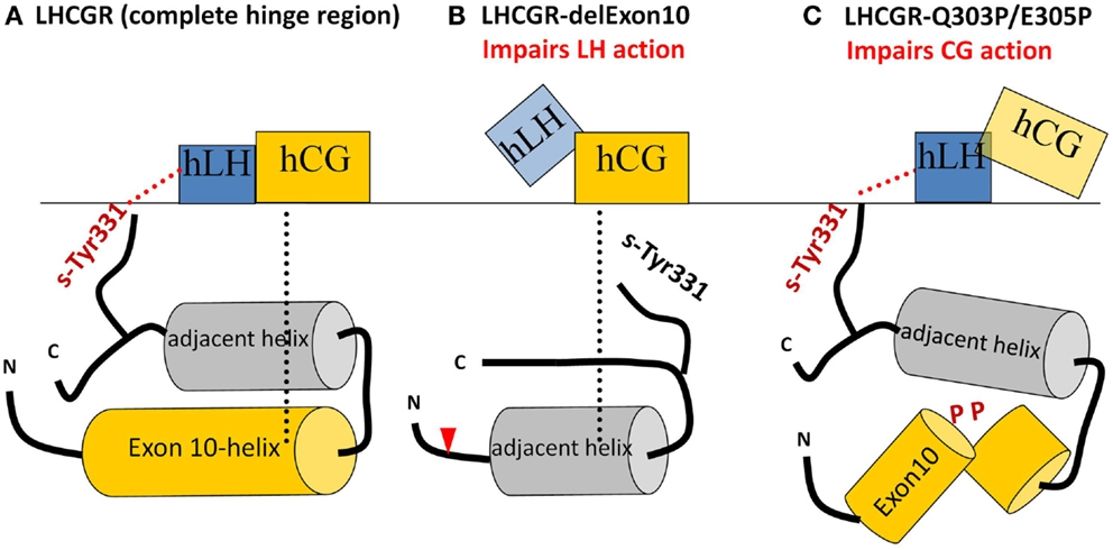Hi-Affi™ LHCGR Stable Cell Line
G-protein coupled receptor (GPCR) superfamily, which transmits various critical physiological signals in a broad range of cell types, has been a hotspot target of modern medicine. They account for the majority of best-selling drugs (about 40% of all prescription pharmaceuticals on the market). Aiming at addressing the increasing research interest in this regard, Creative Biolabs has successfully launched a leading-edge Hi-Affi™ GPCR cell line platform for compound function validation & screening against a diverse GPCRs. Here, we would like to introduce the Hi-Affi™ LHCGR stable cell line to worldwide researchers.
Introduction to LHCGR
The luteinizing hormone/choriogonadotropin receptor (LHCGR) is a transmembrane receptor found predominantly expressed in the ovary and testis, but also many extragonadal organs such as the uterus and breasts. The receptor interacts with both luteinizing hormone (LH) and chorionic gonadotropins (such as hCG in humans) and is indispensable for the hormonal functioning during reproduction.
The LHCGR is composed of 674 amino acids and has a molecular mass around 85-95 kDa depending on the extent of methylation. It is reported that the transmembrane domain contains two highly conserved cysteine residues responsible for building disulfide bonds to stabilize the receptor structure. The extracellular domain of this receptor is heavily glycosylated and intracellular domain is rich in serine and threonine residues for possible phosphorylation.
 Fig.1 Sketches of the different hLH and hCG interactions with the middle section of the hinge region with various LHCGR constructs.1, 2
Fig.1 Sketches of the different hLH and hCG interactions with the middle section of the hinge region with various LHCGR constructs.1, 2
Upon binding of LH to the external part of LHCGR, a transduction of the signal takes place that activates the G protein that is bound to the receptor internally. With attached by LH, the receptor change its conformation and mechanically activates the G protein, which subsequently detaches from the receptor and activates the cAMP system.
Hi-Affi™ LHCGR Stable Cell Line
It is known that G protein can modulate hundreds or even thousands of second messenger molecules (e.g. Ca2+, cAMP, DAG) to elicit diverse downstream signaling pathways. Based on the idea that GPCR functions can be studied via second messengers, a special fluorescent biosensor was developed, which can automatically react to activities of second messenger molecules. Upon GPCR motivation/inhibition, changes in second messengers will trigger rapid translocation of the biosensors (from plasma membrane to cytosol). By this means, GPCR agonist/antagonist can be easily characterized/quantified by fluorescence signals.
Hi-Affi™ LHCGR stable cell line was established by stable co-transfecting human luteinizing hormone/choriogonadotropin receptor (LHCGR) and cAMP-sensitive biosensor in U2OS cells. This cell line has proved to be an extra efficient and convenient tool for assaying compounds targeting LHCGR.
Featured Advantages of Hi-Affi™ LHCGR Stable Cell Lines
- Time- and cost-saving
- Easy operations, with no special requirements for reagents or equipment
- Suitable for high-throughput screenings
- No modifications/labeling of LHCGR or downstream pathways, maintaining the native signaling events
In addition to LHCGR, Creative Biolabs now offers a variety of Hi-Affi™ GPCR stable cell lines engineered with cAMP-activated biosensors, including but not limited to:
|
Empowered by our leading-edge technologies and experienced scientific team, Creative Biolabs is dedicated to offering the most satisfactory and reliable assistance to accelerate custom projects of GPCR drug discovery. Now we provide well-established Hi-Affi™ biosensor cell line options to assess calcium-, cAMP-, DAG-related as well as multiplex pathway events of various GPCRs. In the meantime, one-stop custom service to generate specific GPCR cell line is also available. Please don't hesitate to contact us for more information.
References
- Grzesik, Paul, et al. "Differences in signal activation by LH and hCG are mediated by the LH/CG receptor's extracellular hinge region." Frontiers in Endocrinology 6 (2015): 140.
- under Open Access License CC BY 4.0, without modification.
For Research Use Only.
